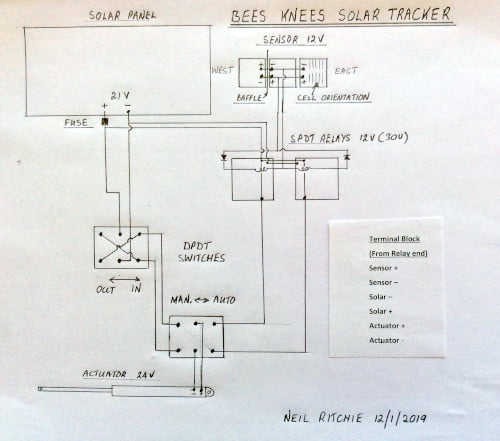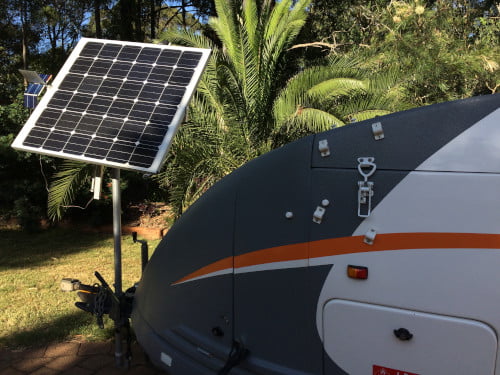Tracking the sun – Solar on the go
How to construct a portable sun tracking solar panel.
Neil Ritchie from Brandy Hill is a member of VOWW (Voice of Wallalong & Woodville). He was the IT manager for Australian Tube Mills for many years. When he retired, Neil’s first project was to build a portable sun tracking solar panel for his camper trailer.
Although large-scale commercial sun tracking solar panels are reasonably common, such as the one at CSIRO’s Newcastle energy research centre, this is the only sun tracking 12v solar panel in existence for recreational vehicles or other camping uses in Australia – to my knowledge!
I am very familiar with what can be achieved with electronics and software but readers might be surprised to read that there are no complex electronics or software in my portable system, because I know their limitations and support issues.
Using basic electro-mechanical components, the system follows the sun through the day with an accuracy within 2 degrees, and then automatically returns to face eastward with the first rays of sunlight the following morning. This project was undertaken as a retirement challenge. The system had to be portable, simple, reliable and robust over rough tracks to remote locations enduring dust, rain, wind and sea spray.

The attraction of sun tracking is that it maximises the daily power output of a solar panel, avoiding the usual solution of just adding more panels. That is impractical with a camper trailer due to the limited space and tare weight. Tracking also avoids the effort of manually moving camping solar panels to chase the sun. The sun tracking mechanism itself had to be compact and lightweight and easily setup, dismantled and stowed.
Compared to the horizontally mounted panel typically used on caravan roofs, a north facing properly tilted panel can generate twice the power when the winter midday sun is low to the horizon. Adding sun tracking adds another 60% output over a fixed north facing panel, in all seasons. So a properly tilted sun tracking panel can produce over three times the power of a horizontal panel.
My solar panel is easily mounted facing north and then tilted to suit the latitude and time of year. It takes about 5 minutes to make it operational at a new campsite, and is then fully automatic for the rest of the stay.

The tracking components are weatherproof and weigh only 3.4kg. The linear actuator that moves the panel to follow the sun is powered from the 12v solar panel and switched using circuitry from this website.
The control system comprises the sensor made from tiny solar panels and a pair of diodes and relays to drive the actuator motor in one direction on a positive voltage and the other on a negative. If more sunlight strikes mini panel A than B, a positive control voltage is produced to incrementally track the sun. If B gets more sunlight than A, a negative control voltage results in the panel returning to the dawn position. Manual control is also available for cloudy and low light conditions.
The best commercial tracking systems will control all 3 axis of rotation. My system only automates 1, but the other 2 (north and midday tilt) are set to the ideal angles at each location, so the system is almost as effective as the best possible.
I use my phone compass app to find show true north (works even without signal). The main panel support arm is then tilted to aim at the midday sun. This angle above the horizon varies with latitude and time of year. A good website for that angle is Solar Handbook. Just enter your country and nearest town.The tracking system then rotates the panel to follow the arc of the sun throughout the day.
The panel can be mounted on a mast on the camper trailer drawbar, or on a ground stand so I can deploy it in a sunny clearing if we are camped in the shade. The ground stand gets screwed to the ground using screw-in tent pegs, for wind stability and security.

The small hinged solar module that is hanging vertically down on the sensor array at the left of the next photo, is there to catch the morning sun when the panel and the main sensor is facing west at the end of the previous day.
I have been using this system for 3 years, and it has worked perfectly every time with no support or maintenance issues. It keeps the batteries charged to power the fridge, lights, water pump and other camping essentials. It certainly has sparked interest in many people that have seen it. I have been very pleased with my first retirement project. We look forward to being able to get away to use it again.
I have a few other projects in progress for my apiary (both honey and native bees), camper trailer and home garden to keep me busy in the meantime.
Neil Ritchie, September 2021.
Neil is available to answer any questions about the system. Please contact us at EcoNetwork and we will put you in touch with him.
